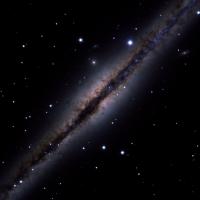SAO Research Highlights
Each edition of the SAO e-zine will feature a research highlight from one of the SAO
teaching staff, either one of our instructors or project supervisors. This issue,
Alister Graham, an SAO instructor and Swinburne researcher,
discusses his work (in collaboration with Simon Driver, another SAO instructor!) on
the effects that galactic dust has on our view of the Universe.
Astronomers have known for a long time that galaxies, including our
own Milky Way, contain clouds of dust - tiny grains of silicate and graphite.
Indeed, such dust is clearly evident in the image below of the disc
galaxy NGC 891.
Dusty edge-on spiral galaxy NGC 891. Credit: C.Howk (JHU), B.Savage (U. Wisconsin), N.A.Sharp
(NOAO)/WIYN/NOAO/NSF
However, what had not been appreciated was the full extent to which this dust
obscures the stellar light from galaxies.
This semester an international team of astronomers, including Dr
Alister Graham, believe they have resolved
this issue. What they found will have far reaching consequences for
not only the way we view our Universe, but also our quantitative
understanding of it.
After carefully measuring the brightness of thousands of disc-shaped
galaxies with different orientations, the astronomers matched their
observations to computer models of dusty galaxies.
From this they were able to calibrate the models and, for the first
time, determine how much light is obscured when a galaxy has a face-on
orientation. This then allowed them to determine the absolute fraction
of light that escapes in each direction from a galaxy. What they
found is that, on average, only half of the visible (blue light)
escapes from galaxies, with the rest blocked by the dust. What this
means is, if it where not for the dust, the Universe would be twice as
bright at optical wavelengths. At ultraviolet wavelengths, the
situation is even more dire, with only a mere ten percent of the light
escaping into the Universe.
The team were able to check their results in a somewhat novel manner.
When the dust obscures the starlight, it is effectively heated and
then subsequently glows at infrared wavelengths, just like thermal
images of warm bodies seen with military night vision goggles. It
turns out that the amount of energy which galaxies are releasing at
these wavelengths, as measured with infrared satellites, exactly
balanced the team's determination of how much UV and visible light was
absorbed by the dust.
For more details, see the
New York Times, the
BBC, and
Driver
et al. (2008), ApJ, 678, L101.
Alister Graham obtained his PhD from the Australian National University in 1998 and joined the Swinburne Centre for Astrophysics & Supercomputing in November 2006. He previously held various positions in Europe (1998-2001), the USA (2002-2004), and at Mount Stromlo & Siding Spring Observatories (2005-2006). Alister studies the distribution and motion of stars in galaxies, and the properties of their dark matter halos. He also uses the Hubble Space Telescope to probe their nuclei, and discovered the supermassive black hole mass versus galaxy concentration relation. He is the instructor of HET606 - Tools of Modern Astronomy.








